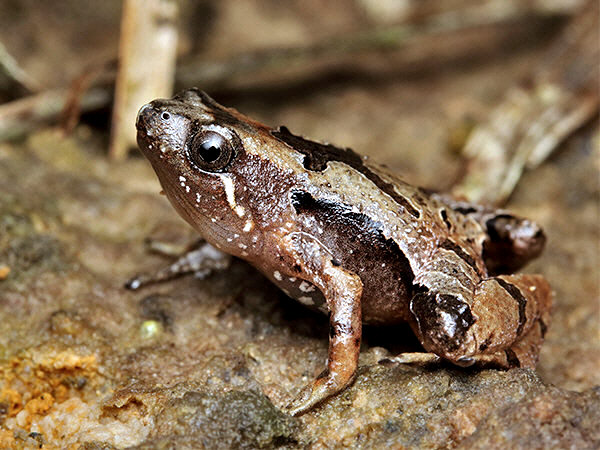 |
Family : MICROHYLIDAE
Species : Microhyla (Nanohyla) annectens
Size (snout to vent) : Female 1.8 cm, Male 1.6 cm
More commonly called
'Larut Hills Rice Frog', this small amphibian inhabits upper hill and
montane areas of Peninsular Malaysia, up to elevations of around 1500 metres.
During rainy conditions these tiny frogs will congregate around small pools
on the forest floor to breed.
In the field, this species can be identified by its patterning and
colouration which comprises a brownish dorsum with a large, distinctive,
symmetrical, dark brown marking in the centre, and dark brown markings on
the upper flanks. There is a pale streak extending from the eye towards the
rear of jaw, and a single well-defined, narrow, dark cross bar is present on
the thigh. The belly is pale or marbled.
The tadpole has a rounded head, small eyes which are positioned laterally,
and an area of gold flecks along the dorsal line which broadens towards the
posterior part of the body. Scattered gold flecks may also occur towards the
snout.
This species is endemic to Peninsular Malaysia, and it appears largely
restricted to upland areas including the western mountain range called Banjaran
Bintang (Grismer et al, 2010), and the Titiwangsa mountains (= 'main range') which
make up the central spine of the peninsula.
In the lowlands, there is a
historical record of Microhyla annectens at the entrance to Batu
Caves, Selangor (Boulenger, 1912): it is unclear how a recognised montane
species came to be found in this lowland location, or if the species still
survives there.
Figs 1 and 2 : Example from montane habitat at Genting Highlands.
Fig 3 : The tadpole has a rounded head, small eyes positioned laterally,
and an arrangement of gold flecks along the dorsal line.
All photos thanks to the Law brothers: Law Ingg Thong and Law Ing Sind.
References :
Boulenger GA (1912) A Vertebrate Fauna of the Malay Peninsula from the
Isthmus of Kra to Singapore, including the Adjacent Islands : Reptilia
and Batrachia. Taylor & Francis, London, xiii, 294 pp.
Grismer, L. L., Chan, K. O., Grismer, J. L., Wood Jr, P. L., &
Norhayati, A. (2010). A checklist of the herpetofauna of the Banjaran
Bintang, Peninsular Malaysia. Russian Journal of Herpetology, 17(2),
147-160.
Manthey U., Grossmann W., 1997. Amphibien und Reptilien Sudostasiens.
Natur und Tier - Verlag.
|